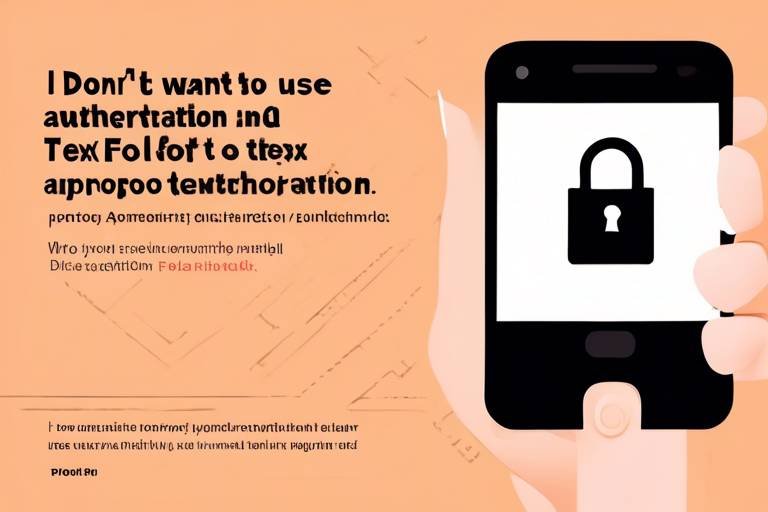Internet Fraud - How to Recognize and Avoid It
In today's digital age, where everything from shopping to banking is done online, the threat of internet fraud looms larger than ever. With just a click, scammers can target unsuspecting individuals, leading to devastating financial losses and emotional distress. So, how can you protect yourself in this vast online landscape? This article explores various forms of internet fraud, how to identify them, and effective strategies to safeguard yourself from falling victim to online scams.
Understanding the different types of internet fraud is crucial for awareness. The internet is a treasure trove for fraudsters, and knowing what to look out for can make a world of difference. Common scams include phishing, identity theft, and online auction fraud. Each of these scams operates under different pretenses, but they all share the same goal: to deceive you into giving away your hard-earned money or personal information.
Phishing scams are deceptive attempts to acquire sensitive information. These scams often masquerade as legitimate communications from trusted sources. Have you ever received an email that looked suspicious but seemed important? That's a classic example of phishing! It's essential to learn how to identify suspicious emails and messages that may lead to identity theft.
Phishing techniques vary widely, from fake emails to fraudulent websites. Scammers are constantly evolving their methods, making it challenging to stay ahead. Here are some prevalent methods used by scammers:
- Email Spoofing: Scammers create emails that appear to be from reputable companies.
- Fake Websites: They design websites that look identical to legitimate ones to steal your login credentials.
- Urgency Tactics: Many phishing emails create a false sense of urgency, prompting you to act quickly without thinking.
Recognizing red flags in communications can prevent scams. Here are key indicators that a message may be fraudulent:
- Unusual sender email addresses.
- Generic greetings like "Dear Customer."
- Requests for personal information.
- Links that don’t match the company’s official website.
Implementing protective measures against phishing is essential. Here are some practical tips on how to safeguard your information:
- Always verify the sender's email address.
- Hover over links to see their true destination before clicking.
- Use two-factor authentication wherever possible.
- Keep your software and antivirus programs updated.
Online auction fraud can lead to financial losses that may take years to recover from. It’s crucial to be vigilant when participating in online auctions. Look for signs of fraudulent listings, such as prices that seem too good to be true or sellers with little to no feedback. Always take the time to research before placing a bid to avoid being scammed.
Online shopping is convenient but can expose you to fraud. To ensure safe and secure online transactions, follow these guidelines:
Choosing the right payment method can enhance your safety. Opt for payment options that offer buyer protection, such as credit cards or reputable payment services like PayPal. Avoid wire transfers or sending cash, as these methods provide little to no recourse if something goes wrong.
Before making a purchase, verifying the seller's credibility is essential. Research the seller by checking their ratings and reviews. Look for red flags, such as a lack of contact information or poor customer feedback. A trustworthy seller will have a solid reputation, so take the time to do your homework.
Reporting internet fraud is vital for prevention. If you encounter a scam, don’t keep it to yourself. Report it to your local authorities and the platform where the fraud occurred. This helps protect others and contributes to the fight against online fraud. Remember, the more we share information about scams, the better equipped we all are to avoid them.
Q: What should I do if I think I've fallen for a scam?
A: If you believe you've been scammed, immediately change your passwords, contact your bank or credit card company, and report the incident to the authorities.
Q: How can I tell if an email is a phishing attempt?
A: Look for signs such as generic greetings, spelling errors, and requests for personal information. Always verify the sender's email address.
Q: Are there any tools to help detect scams?
A: Yes, there are various tools and browser extensions available that can help detect phishing sites and scams. Keeping your antivirus software updated is also crucial.

Types of Internet Fraud
Understanding the different types of internet fraud is crucial for awareness and prevention. The digital landscape, while offering convenience and connectivity, has also become a breeding ground for dishonest individuals looking to exploit unsuspecting victims. Internet fraud can take many forms, and being able to recognize these scams can save you from significant financial loss and emotional distress. The most common types of internet fraud include phishing, identity theft, online auction fraud, and credit card fraud, among others.
Phishing scams are particularly insidious, as they often masquerade as legitimate communications from trusted sources. These scams usually involve emails or messages that appear to be from banks, online services, or even friends, tricking you into revealing sensitive information such as passwords or credit card numbers. Identity theft is another grave concern, where fraudsters steal personal information to impersonate individuals for financial gain. This can happen through various means, including data breaches or social engineering tactics.
Online auction fraud is another prevalent issue, especially on platforms like eBay or Craigslist. Here, scammers create fake listings for items that don't exist or fail to deliver purchased items after payment. Victims often find themselves in a frustrating situation, trying to recover their money without any guarantee of success. Moreover, credit card fraud can occur when your card information is stolen and used without your consent, leading to unauthorized purchases and financial headaches.
In summary, the types of internet fraud can be broadly categorized as follows:
| Type of Fraud | Description |
|---|---|
| Phishing | Deceptive attempts to acquire sensitive information via emails or messages. |
| Identity Theft | Stealing personal information to impersonate someone for financial gain. |
| Online Auction Fraud | Creating fake listings or failing to deliver purchased items. |
| Credit Card Fraud | Unauthorized use of credit card information for purchases. |
By understanding these common forms of fraud, you can better equip yourself to recognize potential threats and take proactive measures to protect your personal information. Always remember that if something seems too good to be true, it probably is!

Recognizing Phishing Scams
Phishing scams are like the wolves in sheep's clothing of the online world. They disguise themselves as trustworthy entities to trick you into giving away your sensitive information, such as passwords, credit card numbers, or social security numbers. Imagine receiving an email that looks like it’s from your bank, asking you to verify your account details. At first glance, it seems legitimate, but a closer inspection reveals that it’s a cleverly crafted trap. Recognizing these scams is crucial in protecting yourself from identity theft and financial loss.
One of the most common methods used in phishing is through emails that appear to come from reputable sources. These messages often contain urgent language, such as “Your account will be suspended unless you act now!” This sense of urgency is designed to provoke a hasty response, leading you to click on malicious links or provide personal information. It’s essential to remain calm and analyze the situation before taking any action.
Phishing can also occur through text messages or even phone calls, known as vishing (voice phishing). For instance, you might receive a text claiming to be from a delivery service, asking you to confirm your address via a link. If you click that link, you could unknowingly download malware onto your device or expose your personal information to scammers. The key here is to verify the sender before engaging with any suspicious messages.
Scammers employ various techniques to deceive their victims. Here are a few prevalent methods:
- Fake Websites: These are websites that mimic legitimate sites to harvest your login credentials.
- Malicious Attachments: Emails may contain attachments that, when opened, install malware on your device.
- Social Engineering: Scammers often use personal information gleaned from social media to make their attacks more convincing.
Being aware of these tactics is the first step in safeguarding yourself. Always check the URL of a website before entering any personal information. Legitimate sites will have URLs that begin with “https://” and display a padlock icon in the address bar. If you notice any discrepancies, it’s a red flag!
When it comes to phishing scams, identifying red flags can save you from potential disaster. Here are some key indicators to look out for:
- Generic Greetings: Phishing emails often start with “Dear Customer” instead of using your name.
- Spelling and Grammar Mistakes: Many phishing attempts are poorly written, filled with spelling errors and awkward phrasing.
- Unusual Requests: Be wary of any request for sensitive information via email or text. Legitimate companies rarely ask for personal data this way.
Always trust your instincts. If something feels off, don’t hesitate to double-check the source. Contact the company directly using official channels to verify any suspicious communications.
Implementing protective measures against phishing is essential in today’s digital age. Here are some practical tips to safeguard your information:
- Use Strong Passwords: Create complex passwords and change them regularly. Consider using a password manager to keep track of them.
- Enable Two-Factor Authentication: This adds an extra layer of security by requiring a second form of verification.
- Install Security Software: Keeping your antivirus software updated can help detect and block phishing attempts.
Additionally, regularly educate yourself about the latest phishing techniques. Scammers are constantly evolving their methods, so staying informed is your best defense.

Common Phishing Techniques
Phishing scams are like digital wolves in sheep's clothing, cleverly disguised to trick unsuspecting individuals into revealing sensitive information. These scams come in various forms, and being aware of the most common techniques can help you steer clear of trouble. One prevalent method is the use of deceptive emails. Scammers often send emails that appear to be from reputable organizations, such as banks or online retailers, urging you to click on a link or provide personal information. These emails can be incredibly convincing, often using logos and language that mimic legitimate companies.
Another common technique involves fraudulent websites. Scammers create look-alike websites that are almost identical to the real ones, complete with similar URLs. A classic example is a fake banking site that closely resembles your actual bank's website. If you're not paying close attention, it can be easy to get duped into entering your login credentials or financial details. Always double-check URLs and look for the secure connection indicator (the padlock symbol) in your browser before entering any sensitive information.
Moreover, social engineering plays a significant role in phishing schemes. Scammers often rely on emotional triggers, like urgency or fear, to manipulate victims into taking immediate action without thinking. For instance, you might receive a message claiming that your account has been compromised, urging you to reset your password immediately. This tactic exploits your natural instinct to protect your personal information, making you more susceptible to falling for the scam.
Additionally, SMS phishing, or "smishing," has become increasingly common. In this scenario, scammers send text messages that contain links to malicious websites or request personal information directly. These messages can appear to be from legitimate sources, like your mobile provider or a popular online service. Just like with emails, it's crucial to be skeptical of unexpected messages and verify their authenticity before taking any action.
To help you better understand these techniques, here’s a quick overview of some common phishing methods:
| Phishing Technique | Description |
|---|---|
| Deceptive Emails | Emails that impersonate legitimate organizations to trick users into providing personal information. |
| Fraudulent Websites | Fake websites designed to look like real ones to capture sensitive data. |
| Social Engineering | Manipulative tactics that exploit emotions to prompt quick responses from victims. |
| SMS Phishing (Smishing) | Text messages that trick users into revealing personal information or clicking on malicious links. |
By recognizing these common phishing techniques, you can arm yourself with the knowledge needed to protect your personal information. Always remember: if something seems off, trust your instincts and investigate further before taking any action. Staying informed and vigilant is your best defense against these cunning scams.

Spotting Red Flags
When it comes to internet fraud, being vigilant is your best defense. Just like a seasoned detective, you need to train your eye to spot the red flags that signal something suspicious. These warning signs are often subtle, but they can save you from falling into a scammer's trap. For instance, if you receive an email that seems slightly off, such as a misspelled company name or an unusual sender address, it’s time to raise your eyebrows. Scammers often impersonate trusted brands, and a simple typo can be a huge clue that something isn't quite right.
Another common red flag is the urgency of the message. Scammers thrive on creating a sense of panic or excitement. If an email or message insists that you must act immediately to claim a prize or avoid a penalty, take a step back. Legitimate organizations typically won’t pressure you into making quick decisions. Instead, they encourage you to take your time, review the information, and reach out to them directly if you have questions.
Moreover, be wary of messages that ask for personal information or financial details. A legitimate company will never ask you to provide sensitive information via email or text. If you’re ever in doubt, don’t hesitate to contact the organization directly using verified contact methods. This simple precaution can help you verify whether the request is genuine or just another scam.
One effective way to identify these red flags is to familiarize yourself with common scam tactics. For example, phishing emails often contain generic greetings like “Dear Customer” instead of your name. They might also include links that lead to fake websites designed to steal your information. Always hover over links before clicking to see the actual URL. If it looks suspicious or doesn’t match the supposed source, don’t click!
Here's a quick reference table summarizing some common red flags to look out for:
| Red Flag | Description |
|---|---|
| Generic Greetings | Messages that don’t address you by name. |
| Urgency | Pressure to act quickly to avoid negative consequences. |
| Requests for Personal Info | Asking for sensitive information via email or text. |
| Suspicious Links | Links that lead to unfamiliar or misspelled websites. |
By keeping an eye out for these red flags, you can significantly reduce your chances of becoming a victim of internet fraud. Remember, if something feels off, trust your instincts. It’s always better to be safe than sorry!
Q: What should I do if I think I've been scammed?
A: If you suspect you've fallen victim to a scam, immediately report it to your local authorities and the relevant consumer protection agency. Change your passwords and monitor your accounts for any unusual activity.
Q: How can I protect myself from phishing scams?
A: Always verify the sender's email address, avoid clicking on suspicious links, and use two-factor authentication whenever possible to add an extra layer of security.
Q: Are there specific signs that indicate online auction fraud?
A: Yes! Be cautious of listings with prices that seem too good to be true, sellers who refuse to provide additional information, and lack of seller ratings or reviews.

Protective Measures
In today's digital age, where the internet is an integral part of our lives, taking against internet fraud is more important than ever. Think of your online presence as a house; if you leave the doors and windows wide open, you're inviting trouble. So, how can you fortify your digital home? Here are some essential steps to consider:
First and foremost, always use strong, unique passwords for each of your online accounts. A password manager can help you keep track of them without having to write them down. It's like having a personal vault for your keys! Additionally, enable two-factor authentication whenever possible. This adds an extra layer of security beyond just your password, making it much harder for fraudsters to gain access.
Next, be cautious about the information you share online. Scammers often use social engineering techniques to gather personal data. For instance, if you post your birthday or address on social media, you might be inadvertently giving them the keys to your kingdom. Always think twice before sharing sensitive information, and adjust your privacy settings to limit who can see your posts.
Another critical measure is to stay updated on the latest scams. Fraud tactics are constantly evolving, and being aware of current schemes can help you recognize them more quickly. Follow reliable sources, like consumer protection websites or your bank's fraud alerts, to keep yourself informed. Knowledge is power, and in this case, it can save you from falling victim to scams.
Furthermore, it’s essential to regularly monitor your financial statements. Check your bank and credit card statements for any unauthorized transactions. If something looks suspicious, report it immediately. It's much easier to resolve issues when you catch them early. Consider setting up alerts for transactions over a certain amount, so you're notified instantly.
Lastly, trust your instincts. If something feels off—like an email that seems too good to be true or a website that looks unprofessional—don't hesitate to investigate further. A little skepticism can go a long way in protecting yourself from fraud. Remember, if it looks like a duck and quacks like a duck, it might just be a scam.
By implementing these protective measures, you can significantly reduce your risk of becoming a victim of internet fraud. Just like you wouldn’t leave your house unlocked, don’t leave your online accounts vulnerable. Stay vigilant, stay informed, and keep your digital life secure!
- What should I do if I think I've been scammed? If you suspect you've been a victim of fraud, contact your bank immediately, change your passwords, and report the incident to the authorities.
- How can I tell if an email is a phishing attempt? Look for poor grammar, generic greetings, and suspicious links. If the sender's email address seems off, that's a red flag!
- Is it safe to shop online? Yes, as long as you follow safe online shopping practices, such as using secure payment methods and verifying seller credibility.

Identifying Online Auction Fraud
Online auctions can be a treasure trove of deals, but they can also hide a minefield of fraud waiting to ensnare the unsuspecting buyer. Imagine browsing through pages of exciting items, only to find out later that you’ve been duped. The thrill of the hunt can quickly turn into a nightmare if you're not vigilant. So, how do you navigate this digital marketplace without falling prey to scammers? Let’s dive into the key signs of online auction fraud and how you can protect yourself.
One of the first things to watch out for is unrealistic pricing. If an item is listed at a price that seems too good to be true, it probably is. Scammers often lure in victims by offering high-demand items—like the latest tech gadgets or rare collectibles—at a fraction of the market price. Always do your research and compare prices across multiple platforms before making a bid. If you find a deal that’s significantly lower than what you’ve seen elsewhere, it’s a red flag.
Another common tactic used by fraudsters is the use of fake profiles. Many auction sites allow users to create profiles that can be easily manipulated. If a seller has little to no feedback, or if their profile seems incomplete or generic, proceed with caution. Take a moment to look for reviews or ratings from previous buyers. A reputable seller will typically have positive feedback and a history of successful transactions. If you see a profile with an unusually high number of sales but no reviews, that could indicate foul play.
Additionally, pay attention to the communication style of the seller. Scammers often rush buyers into making decisions. If a seller is pressuring you to complete a transaction quickly or is evasive when you ask for more information, it’s time to reconsider. Genuine sellers are usually more than willing to answer your questions and provide additional details about the product. Make sure to ask for clear photos of the item, especially if it’s a high-value purchase. If the seller refuses or provides stock images instead, that’s a significant warning sign.
Lastly, always check the payment methods accepted by the seller. Legitimate auction sites typically offer secure payment options that provide buyer protection. If a seller insists on using wire transfers, prepaid gift cards, or any method that doesn’t offer fraud protection, it’s a clear indication of potential fraud. Stick to secure payment options that allow for dispute resolution, as this can save you a lot of headaches in the long run.
In summary, online auction fraud can be tricky to spot, but by staying alert and following these guidelines, you can significantly reduce your risk. Always approach deals with caution, do your homework, and trust your instincts. If something feels off, it probably is. Remember, the goal is to enjoy your online shopping experience without the dark cloud of fraud hanging overhead.
- What should I do if I suspect fraud on an auction site?
If you suspect fraud, report the seller immediately to the auction site and gather any evidence you have, such as screenshots and communication records. - Can I get my money back if I fall victim to online auction fraud?
It depends on the payment method used. If you used a credit card or a secure payment service, you may be able to dispute the charge and get your money back. - How can I protect myself when bidding on items online?
Always research the seller, read reviews, and use secure payment methods. If a deal seems too good to be true, it probably is.

Safe Online Shopping Practices
Shopping online can be a delightful experience, offering convenience and a plethora of options at your fingertips. However, it also opens the door to potential risks that can lead to financial loss and identity theft. To enjoy the perks of online shopping without falling into the traps set by fraudsters, you need to arm yourself with some essential practices. Remember, just like you wouldn't walk into a dark alley at night, you shouldn't venture into the online marketplace without proper precautions!
First and foremost, always shop on secure websites. Look for URLs that begin with https:// instead of just http://. The 's' stands for secure, indicating that the site encrypts your data during transmission. Additionally, check for a padlock icon in the address bar, which signifies that the site is secure. If a website lacks these features, think twice before entering your personal information.
When it comes to payment methods, your choices can make a significant difference in your safety. Using secure payment methods such as credit cards, PayPal, or other reputable payment services can provide an added layer of protection. Credit cards often have fraud protection policies that can shield you from unauthorized charges, while services like PayPal act as intermediaries that keep your financial details private. Avoid using direct bank transfers or debit cards, as these can expose your account to higher risks.
Another critical aspect of safe online shopping is verifying seller credibility. Before making a purchase, take a moment to research the seller. Look for reviews and ratings from previous customers, and check their return policy. If a deal seems too good to be true, it probably is! Scammers often lure in unsuspecting shoppers with unbelievable discounts. A quick search can save you from potential heartache.
To help you navigate the online shopping landscape more safely, here’s a quick table summarizing the best practices:
| Practice | Description |
|---|---|
| Use Secure Websites | Shop on sites with https:// and a padlock icon. |
| Choose Secure Payment Methods | Opt for credit cards or reputable payment services like PayPal. |
| Verify Seller Credibility | Research sellers and read reviews before purchasing. |
Lastly, keep your devices secure. Ensure that your computer or mobile device has up-to-date antivirus and anti-malware software. Cybercriminals often use malicious software to steal personal information. Regularly updating your software can close security gaps that scammers might exploit. Also, consider using a virtual private network (VPN) when shopping on public Wi-Fi networks to encrypt your internet connection.
In conclusion, safe online shopping practices are your best defense against fraud. By being vigilant and following these guidelines, you can enjoy the convenience of online shopping while keeping your personal information and finances secure. Remember, a little caution goes a long way in the digital marketplace!
Q: How can I tell if a website is safe for shopping?
A: Look for URLs that start with https:// and check for a padlock icon in the address bar. Additionally, read customer reviews and check the site's return policy.
Q: What should I do if I suspect I've been scammed?
A: Immediately contact your bank or credit card provider to report the fraud. You should also report the scam to the relevant authorities and consider changing your passwords.
Q: Are there any specific payment methods that are safer than others?
A: Yes, using credit cards or services like PayPal is generally safer than using debit cards or bank transfers, as they often provide better fraud protection.

Using Secure Payment Methods
When it comes to online shopping, one of the most critical aspects to consider is how you pay for your purchases. Using secure payment methods can be the difference between a smooth transaction and a potential nightmare involving fraud. Think of your payment method as a lock on your front door; the stronger the lock, the safer your home. In this digital age, it’s essential to choose payment options that offer robust security features to protect your sensitive financial information.
There are several secure payment methods available today, and understanding them can help you make informed decisions. For instance, credit cards are generally considered safer than debit cards because they often come with fraud protection policies. If someone makes an unauthorized charge, you can dispute it more easily with a credit card company than with a bank. Additionally, many credit cards offer features like virtual card numbers that allow you to shop online without exposing your actual card number.
Another popular option is the use of digital wallets, such as PayPal, Apple Pay, or Google Pay. These services act as intermediaries between your bank account and the merchant, meaning your financial details are never directly shared with the seller. This adds an extra layer of security, making it harder for scammers to access your sensitive information. Moreover, these digital wallets often employ encryption methods to safeguard your data, so you can shop with peace of mind.
Here’s a quick comparison of some secure payment methods:
| Payment Method | Security Features | Pros | Cons |
|---|---|---|---|
| Credit Card | Fraud protection, chargeback options | Widely accepted, good for disputes | Potential for high-interest rates |
| Debit Card | Limited fraud protection | Direct access to your funds | Higher risk of fraud |
| Digital Wallet | Encryption, no sharing of financial details | Convenient, secure transactions | Not all merchants accept them |
While using secure payment methods is crucial, it’s also important to keep an eye on your accounts. Regularly monitoring your bank statements and transaction history can help you catch any suspicious activity early. If you notice anything unusual, report it immediately to your bank or payment provider. Remember, a proactive approach is your best defense against fraud.
In conclusion, choosing the right payment method is essential for safe online shopping. Whether you prefer using a credit card, a debit card, or a digital wallet, ensure that you understand the security features and limitations of each option. By being vigilant and informed, you can significantly reduce your risk of falling victim to online fraud.
- What is the safest payment method for online purchases?
Credit cards and digital wallets are generally considered the safest options due to their robust security features and fraud protection policies.
- How can I protect my payment information while shopping online?
Always use secure payment methods, monitor your transactions, and shop on reputable websites. Additionally, consider using a VPN for extra security.
- What should I do if I suspect fraud on my account?
Contact your bank or payment provider immediately to report the suspicious activity and take the necessary steps to secure your account.

Verifying Seller Credibility
When it comes to online shopping, ensuring that you’re dealing with a credible seller is as crucial as finding the right product. Imagine walking into a store and not knowing if the owner is trustworthy; the same principle applies online. You wouldn’t want to hand over your hard-earned money to someone who might just disappear into thin air, right? So, how do you go about verifying seller credibility before clicking that 'Buy Now' button? Let’s dive into some effective strategies!
First things first, check the seller's feedback and ratings. Most reputable platforms allow buyers to leave reviews about their experiences. Look for sellers with a high number of positive reviews. If a seller has a lot of feedback but a low rating, that’s a huge red flag. Think of it like this: if you were to recommend a restaurant, you’d want to make sure it has good reviews, wouldn’t you? The same logic applies here.
Additionally, examine the seller's profile. A credible seller usually has a well-detailed profile that includes their history, policies, and contact information. If their profile looks sparse or unprofessional, consider it a warning sign. A legitimate seller will want to build trust with potential buyers, and that often means providing as much information as possible.
Another excellent way to verify credibility is to look for signs of professionalism. This can include:
- High-quality product images that reflect the actual items.
- Detailed product descriptions that answer common questions.
- Clear return and refund policies.
If a seller can’t be bothered to present their products well, chances are they might not be serious about their business either.
Don't forget to do a quick web search on the seller. A simple search can reveal if they've been involved in any scams or have a history of complaints. You might find forums or consumer advocacy sites discussing the seller’s reputation. This is akin to asking your friends for recommendations before trying out a new place; it gives you an added layer of insight.
Finally, if you’re still unsure, consider using a payment method that offers buyer protection. Platforms like PayPal or credit cards often provide additional security and can help you recover your money if something goes wrong. Think of it as having insurance; it’s always better to be safe than sorry!
In conclusion, verifying seller credibility is a vital step in the online shopping process. By taking the time to research and assess, you can significantly reduce the risk of falling victim to scams. Remember, a little caution can go a long way in ensuring a smooth and safe online shopping experience!
Q: How can I tell if an online seller is legitimate?
A: Look for positive reviews, detailed profiles, and professional presentation of products. Conduct a web search for any complaints or scams associated with the seller.
Q: What should I do if I suspect a seller is fraudulent?
A: Avoid making a purchase, report the seller to the platform, and consider sharing your experience on consumer advocacy sites.
Q: Are there payment methods that offer better protection against fraud?
A: Yes, using services like PayPal or credit cards typically provides buyer protection, which can help you recover funds if needed.

Reporting Internet Fraud
Reporting internet fraud is not just a civic duty; it's a crucial step in combating the ever-evolving landscape of online scams. When you report fraud, you not only protect yourself but also help others from falling victim to the same schemes. So, how do you go about it? First, it's essential to gather as much information as possible about the fraudulent activity. This includes screenshots of suspicious emails, URLs of fake websites, and any correspondence you may have had with the scammer. The more details you provide, the better the authorities can investigate.
Once you've compiled your evidence, the next step is to determine where to report the fraud. Various organizations and agencies are dedicated to tackling internet fraud, and they often have specific reporting procedures. Here’s a quick guide on where to report different types of online scams:
| Type of Fraud | Where to Report |
|---|---|
| Phishing Scams | Anti-Phishing Working Group |
| Identity Theft | IdentityTheft.gov |
| Online Auction Fraud | Internet Crime Complaint Center (IC3) |
| General Internet Fraud | Federal Trade Commission (FTC) |
Each of these organizations has its own set of guidelines for reporting fraud, so make sure to follow their instructions carefully. Additionally, if you’ve lost money or personal information, it’s wise to contact your bank or credit card company immediately. They can help you take steps to secure your accounts and possibly recover lost funds.
But wait, there's more! Have you ever thought about the power of community? Sharing your experience with friends and family can also be a form of prevention. By educating those around you about the signs of internet fraud, you create a ripple effect that can help keep everyone safer online. It’s like building a fortress of knowledge—one that can withstand the attacks of scammers!
In conclusion, the fight against internet fraud is a collective effort. By reporting scams, educating others, and staying vigilant, we can all contribute to a safer online environment. Remember, if something seems too good to be true, it probably is. So, keep your eyes peeled and don’t hesitate to take action if you suspect fraud. Together, we can make a difference!
- What should I do if I think I've been scammed? If you suspect you've been a victim of fraud, gather all relevant information and report it to the appropriate authorities immediately.
- Can I report fraud anonymously? Yes, many organizations allow for anonymous reporting, but providing your contact information can help with investigations.
- How can I protect myself from future scams? Regularly update your passwords, be cautious with personal information, and stay informed about common scams.
Frequently Asked Questions
- What is internet fraud?
Internet fraud refers to any deceptive activity conducted online with the intent to gain financial or personal information from unsuspecting victims. This can include scams such as phishing, identity theft, and auction fraud.
- How can I recognize phishing scams?
Phishing scams often come in the form of emails or messages that appear legitimate but are designed to trick you into providing sensitive information. Look for red flags like poor grammar, urgent language, and suspicious links.
- What should I do if I receive a suspicious email?
If you receive a suspicious email, do not click on any links or provide any personal information. Instead, verify the sender's email address and report the email as spam or phishing to your email provider.
- How can I protect myself from online auction fraud?
To protect yourself from online auction fraud, always research the seller, read reviews, and be wary of deals that seem too good to be true. Use secure payment methods and avoid making transactions outside the auction platform.
- What are the safest payment methods for online shopping?
The safest payment methods for online shopping include credit cards, which offer fraud protection, and payment services like PayPal that provide an extra layer of security. Avoid using direct bank transfers or sending cash.
- How can I verify a seller's credibility?
To verify a seller's credibility, check their ratings and reviews on the auction site, look for contact information, and research their online presence. Trustworthy sellers usually have a history of positive feedback from buyers.
- What should I do if I fall victim to internet fraud?
If you fall victim to internet fraud, immediately report the incident to your bank or credit card company, change your passwords, and report the scam to local authorities and online platforms. Prompt action can help mitigate damages.
- How can I report internet fraud?
You can report internet fraud to your local law enforcement agency, the Federal Trade Commission (FTC) in the U.S., or through online platforms dedicated to fraud reporting. Providing detailed information can help in investigations.



















